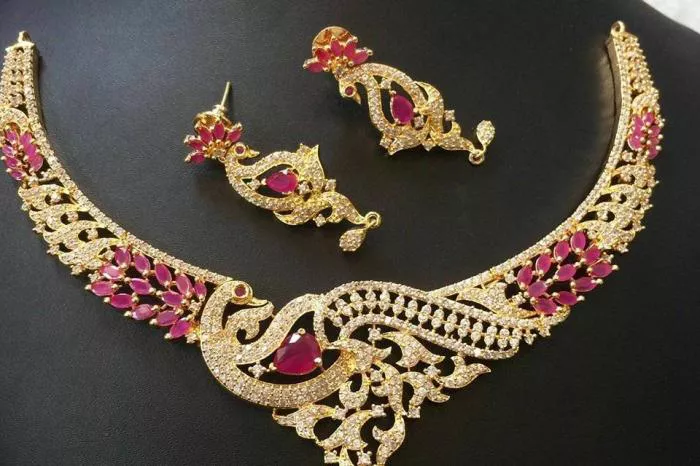Rajkot, India – The once-thriving imitation jewelry business in Rajkot is facing significant challenges as cheaper Chinese products flood the market. Manufacturers and artisans are experiencing a stark decline in sales, leading to a profound impact on the local economy and livelihoods.
Declining Sales Figures
Just five months ago, Narendra Mehta, a prominent imitation jewelry maker in Rajkot, sold approximately 250 to 300 kilograms of ornaments daily. However, recent reports indicate a drastic decrease, with sales now hovering between 100 and 150 kilograms per day. This slump has forced Mehta to reduce his orders significantly, impacting the livelihoods of the artisans he collaborates with.
Previously, Mehta placed orders with around 200 families who crafted jewelry from their homes. Today, that number has dwindled to only 50 to 60 families receiving work. The situation underscores the dire circumstances facing Rajkot’s famous imitation jewelry sector, which has been a staple in Bollywood films and television series.
The Competitive Edge of Chinese Jewelry
The rapid decline in Rajkot’s imitation jewelry business is largely attributed to the influx of inexpensive Chinese jewelry. These products not only offer lower prices but also feature designs that closely resemble those crafted in Rajkot, making it difficult for local artisans to compete.
According to local manufacturers, sales in the domestic market have plummeted by 25% over the last five to six months. Exports, which were once a reliable revenue source, have seen an alarming drop of approximately 40%. The workforce involved in creating this jewelry primarily consists of individuals from West Bengal and other eastern parts of India, who typically produce the ornaments in their homes. Manufacturers supply them with materials and designs, facilitating the production process.
Shift in Raw Material Sourcing
Historically, Rajkot manufacturers sourced 80% of their raw materials for imitation jewelry from China. However, over recent years, Chinese manufacturers have begun to develop their own designs tailored to the Indian market. “China initially focused on creating designs popular in Western countries like the US and Canada. Now, they are producing jewelry preferred by consumers in the Indian subcontinent and Gulf regions,” Mehta explained.
This shift in design strategy has made Chinese jewelry increasingly appealing to local buyers, further exacerbating the challenges faced by Rajkot’s artisans.
Advancements in Manufacturing Techniques
Manufacturers in Rajkot acknowledge that their Chinese competitors have advanced machinery, which allows for a superior finish on their products. This technological edge has been bolstered by support from the Chinese government, enabling manufacturers to produce lightweight jewelry with diverse designs that cater to various consumer preferences.
Manish Patel, president of the Imitation Jewelry Association in Rajkot, noted, “Chinese jewelry is priced 20% to 25% lower than our products. Even when factoring in import costs, if Chinese jewelry is competitively priced, customers tend to prefer their designs.”
Trade Dynamics and Export Patterns
Although Rajkot traders do not engage in direct exports, they supply imitation jewelry to larger cities such as Mumbai, Bengaluru, Chennai, Jaipur, and Kolkata. Traders in Mumbai and Delhi handle exports to Gulf and African countries, while Kolkata-based traders export to Bangladesh. This intercity trade network has been crucial for the Rajkot jewelry market, but the current competitive landscape is threatening its sustainability.
Traditionally, Rajkot-based manufacturers would receive substantial orders during festive seasons, especially during Navratri. However, this year, overall sales have declined by 30%. Manufacturers are now apprehensive about the upcoming Diwali festival and the marriage season, fearing that Chinese products will dominate these lucrative markets.
Calls for Government Support
Jignesh Shah, another jewelry manufacturer in Rajkot, expressed concerns about the growing dominance of Chinese imitation jewelry. “China has always exported imitation jewelry to India, but the penetration of these products has significantly increased now,” he stated. Shah advocates for the Indian government to implement an “ease of doing business” policy similar to that of China, aimed at providing local artisans and manufacturers with the necessary support to compete effectively.
Impact on Artisans and Local Economy
The ramifications of these market changes are profound, particularly for the artisans who rely on the imitation jewelry sector for their livelihood. Many of these workers have already faced financial hardships due to reduced orders, and the prospect of continued decline poses a serious threat to their economic stability.
With fewer families engaged in jewelry-making, there is a growing concern about the preservation of traditional craftsmanship and the rich cultural heritage associated with Rajkot’s imitation jewelry industry. The shift towards cheaper Chinese alternatives not only undermines local artisans but also risks erasing a significant part of the region’s identity.
Future Prospects
As Rajkot’s imitation jewelry industry grapples with these challenges, the need for innovation and adaptation becomes increasingly critical. Manufacturers may need to explore new design trends and materials to differentiate their products from the competition. Collaborating with local designers and incorporating traditional craftsmanship into contemporary designs could help revive interest in Rajkot’s jewelry offerings.
Furthermore, increasing awareness among consumers about the value of supporting local artisans may encourage a shift away from imported products. Campaigns promoting “Made in India” initiatives could play a crucial role in revitalizing the local jewelry market.
Conclusion
The imitation jewelry business in Rajkot is at a crossroads, facing unprecedented challenges from cheaper Chinese alternatives. As sales plummet and artisans struggle to maintain their livelihoods, the local industry must adapt to survive. By fostering innovation, seeking government support, and emphasizing the unique qualities of Rajkot’s craftsmanship, the region can work towards revitalizing its imitation jewelry market and preserving its rich cultural heritage.
The future of Rajkot’s imitation jewelry industry depends on the collective efforts of manufacturers, artisans, and policymakers to navigate these turbulent waters and emerge stronger in the face of competition. As the market continues to evolve, it is essential for Rajkot’s jewelry makers to not only survive but thrive, ensuring that the artistry and craftsmanship that have defined the region for decades are not lost to time.
Related topics:

